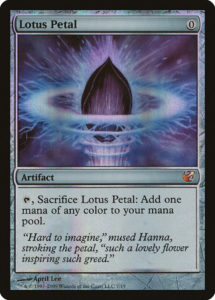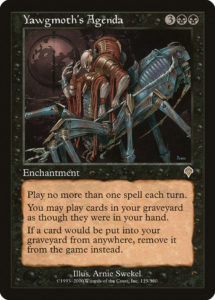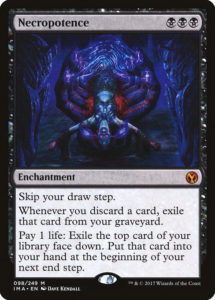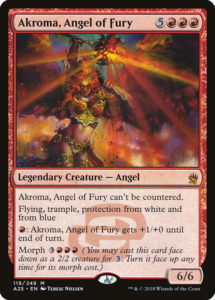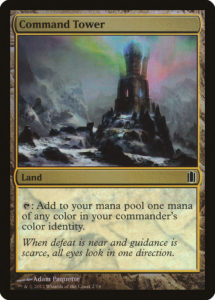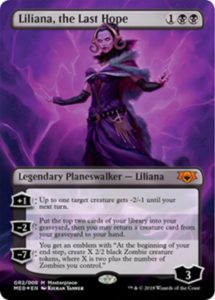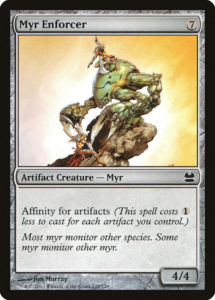Let’s talk about Guilds of Ravnica Mythic Edition. It releases October 3rd on the Hasbro store and will be $250. It contains 24 booster packs of Guilds of Ravnica, eight of which are specially marked and contain one of eight reprinted planeswalkers with new art and special borders. Plenty of ink has been spilled over whether this product should exist. Today, I’d instead like to posit why it does.
Where’d Mythic Edition come from?
Mythic Edition is a new product, but not one without precedent. It’s an evolution of From the Vault—a prior premium product containing valuable chase cards which usually sold well above MSRP. Over time, the quality of From the Vault depreciated and it was discontinued.
Guilds of Ravnica combines From the Vault’s premium reprints with 24 booster packs, a Masters-size booster box. An interesting number, and one worth diving into. For the moment, let’s table Mythic Edition and talk about comparable premium products, most notably the Masters line.
A Stuttering Pace
The past two years of Magic have been heavily defined by a slew of draftable supplementary sets. 2016 had Eternal Masters and Conspiracy: Take the Crown in addition to the Standard four expansions (and was the year the Masters series became an annual product, rather than biennial).The following year had Modern Masters 2017, Iconic Masters, and Unstable (and was the year the Masters series became semi-annual).
2018 had Masters 25 and Battlebond in the first half of the year—and then nothing. A few small product releases (mostly focused on introductory play), but neither a second Masters set nor a special product release. Magic had swiftly gone from a slew of special releases in the first half of Magic’s big 25th anniversary, to none. Perhaps most surprisingly, there was no product for enfranchised players during the summer of Core 2019, an expansion pushed first and foremost as an introductory product—the perfect time for a complicated Masters set. What happened?
The Sinking of the Supplemental Flagship
The Masters line is almost certainly the most successful supplemental product Magic has ever had. Modern Masters 2013 sold out its entire print run and shattered Yu-Gi-Oh’s record for largest TCG tournament at GP Vegas, until Modern Masters 2015 blew both of them out of the water two years later. However, the two most recent installments, Iconic Masters and Masters 25, constituted a one-two punch that damaged the entire Masters line.
Iconic Masters was full of low-supply, low-demand reprints like Mana Drain that couldn’t support its high price point (and a mix of low-supply, low-demand, low-value mythics like Channel, Necropotence, and Ob Nixilis, the Fallen that were essentially worthless). Its Limited environment was dominated by simple and overlapping archetypes, restricting replayability and excitement. It was released a full two months after being spoiled (allowing the market adjust to the increased supply and card prices to fall well before IMA was available for purchases) and in the middle of Unstable spoiler season (so that enthusiasm and attention were elsewhere). Even its name was confusing, since iconic cards and creature types were an icing on the top of the set, rather than present in each mouthful. Iconic Masters had the odds stacked against it, and it was not successful.
The Finishing Blow
Masters 25 promised to buck Iconic Master’s trend. It released at the perfect time, the tail end of Rivals of Ixalan, and competed with nothing else. It contained the highly desirable Jace, the Mind Sculptor who was unbanned in Modern a month before Masters 25 released. It had a high-synergy, high-power format reminiscent of Modern Masters 2017 and was the most Jenny-focused Masters set ever seen. It also included valuable reprints tailored towards Commander (something previously done in IMA’s reprinting of all five New Phyrexia Praetors) and Cube, rather than merely tournament play. It had gorgeous watermarks. The odds were stacked in its favor.
And yet, Masters 25 fell far short of the mark, failing to justify and selling well below its high price tag, just as IMA did. When Dominaria released the following month, my local game stores could be divided into two camps: those who’d drastically underbought Masters sets, and those down thousands or tens of thousands of dollars on product they couldn’t move at a profit.
Masters is presently supposed to be a biannual product centered around themes, rather than formats. Masters 25 was meant to herald this new era of Masters sets and reaffirm confidence in the brand after the disaster of Iconic Masters. Instead, the second Masters set of 2018 is nowhere to be found—and it’s far too late in the year for one to come out. I’d wager it was either quietly cancelled or postponed as the product was reimagined, perhaps to revise its price point or contents (or perhaps WotC was merely waiting for the heat to die down). However, there was a hole to be filled in the premium product line, one that couldn’t be patched with a brand new bespoke product. Those time take to design, develop, manufacture, and ship.
And we’ve seen this before.
A Surprise Treat
The year is 2012. Last year, the first Commander preconstructed decks were a resounding success. There was an enormous demand for more such products, however it takes time to craft a set of five balanced decks filled with exciting new Commander-focused designs and mechanics. A hasty solution was found in Commander’s Arsenal, a premium product to tide over demand until 2013, when the Commander line became annual. Commander’s Arsenal’s MSRP was $75, but it had a tiny print run and usually sold for three to four times that amount (if it was even available). Commander’s Arsenal wasn’t a watershed moment for Magic, but it is of note for being a small product, created in a short span of time, in reaction to a big surprise from Magic’s player base.
Now, let’s bring Guilds of Ravnica Mythic Edition back into the mix. I posit that it is 2018’s Commander’s Arsenal. However, where Commander’s Arsenal was created in response to unexpectedly high demand, Mythic Edition is filling a void born of unexpectedly low demand. Mythic Edition replaces the missing second Masters Set of 2018, the second thematic set.
Like Commander’s Arsenal, Mythic Edition is relatively quick to throw together—it requires no new cards to be created, just eight pieces of new artwork, one new border, and new packaging. It was perhaps created so late that it couldn’t be announced or shipped out to stores in time, so it’s being sold directly by Hasbro (which means that instead of LGSes benefiting from the high prices of a $250 product that’s basically a bundling of a From the Vault: Planeswalkers with two-thirds of a booster box, Hasbro benefits and assumes all risk).
So, is it worth it?
Plenty has been said about the issues of Hasbro selling directly to consumers, something they’ve already done with both the San Diego Comic Con planeswalkers and the Hascon promos. And yes, it’s reasonable to expect that scalpers and bots will buy out and flip the limited supply of Mythic Edition at a tidy profit. Setting that aside, should you purchase Mythic Edition?
Mythic Edition certainly offers a lot—if you’ve got $250 to spare, you’re basically paying ~$50 for booster packs and $25 per planeswalker. The supply run is expected to be tiny, so it’ll hardly budge the value of any of the planeswalkers, and all of the reprinted Planeswalkers carry value (just Liliana, the Last Hope and Teferi, Hero of Dominaria is $80 worth of value). And these aren’t just any planeswalkers, but limited edition, gorgeous Masterpieces which are going to be worth more than their original printings. If you care about value (either to own cards or if you’re good at flipping them) Mythic Edition is basically an auto-buy if you can afford it.
Where we stand
I understand that 2018 has seen some more controversial product choices, such as introducing Standard legal cards in Buy-a-box promos (and other products beyond low power level Welcome Decks and Planeswalker Decks) and Mythic Edition. These decisions don’t directly affect me—sure, I enjoy having premium cards for my cube, but I’m not enough of a collector to be hyped about Mythic Edition. However, the vacuum surrounding Mythic Edition is personally significant.
I love Magic’s supplemental releases, playing and enjoying every single one of them (with the notable exception of Battlebond, a product difficult to play in NYC and with issues I’ll get to in a later article). I was dismayed by the problems of the Masters line but hoped that the ship could be righted. After all, I am well within the Masters’ lines’ target demographics. Mythic Edition suggests that Masters sets are substantially damaged and that 2016 and 2017’s accelerating pace of major product releases will be replaced by smaller, more agile releases now and in 2019. This allows whole new audiences to be developed and for products to be designed with much smaller teams, but also means we’ll see fewer draftable products like the Masters sets.
I wish I had more information about Magic’s future, but the latter half of 2018 and beginning of 2019 are defined more by what is absent, rather than what is known. We don’t know next year’s Grand Prix schedule, only that there will be a more flexible approach to the Pro Tour and fewer invitations. We don’t know anything about future supplementary releases, only that there aren’t any more this year. We know about all three Ravnica sets, but there was never any question whether the three major annual releases were going to happen. Where 2018 began with celebrations—Masters 25th anniversary, the return of the Great Designer Search and team Pro Tour, and Challenger Decks (to name but one a slew of experimental products)—the year is closing with a void.
I normally try to end these articles on a high note, but this one is particularly difficult to do so. Mythic Edition is a likely symptom of the weakness of one of my favorite product lines. The near future of Magic may be defined by an overreaction to the overstuffed summers of 2016 and 2017 and the preventable failures that hurt the Masters line. Magic is still a wonderful game and I’m deeply excited for the next three sets on Ravnica, but I worry that over the next year, that’s all I’ll have to be excited about. Here’s looking forward to more joyful products I didn’t even know I wanted, like Unstable.
And, as always, thanks for reading.
—Zachary Barash
Zachary Barash is a New York City-based game designer. He designs for Kingdom Death: Monster, has a Game Design MFA from the NYU Game Center, and does freelance game design. When the stars align, he streams Magic.
His favorite card of the month is Syndic of Tithes. Sometimes, a simple but powerful mechanic on a simple, but serviceable is all a card needs to shine.

